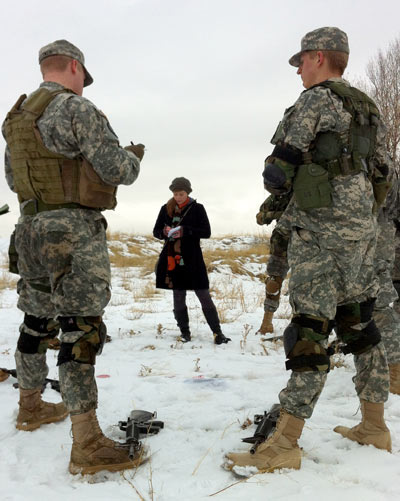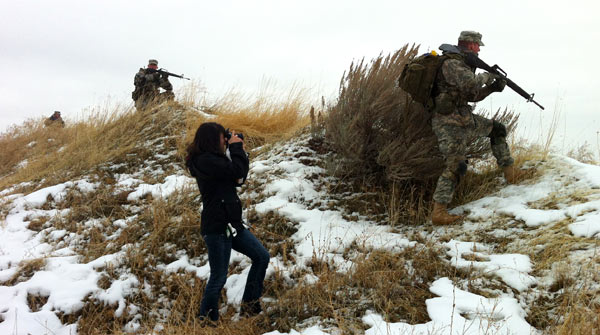Journalism students embed with Army ROTC cadets for war games
February 12th, 2012 Posted in OpinionNORTH LOGAN—“Does anyone know how to evaluate a casualty?”
 Kevin Moultrie asks the question and the 10 members of Alpha and Bravo squads, braced along a diving, snow-frosted hillside near North Logan’s Green Canyon, momentarily pause before John Gillespie springs into action. He begins to apply the eight-step process for checking if a soldier is dead on his fellow cadet, Nathan Griffin, who has been shot in the leg.
Kevin Moultrie asks the question and the 10 members of Alpha and Bravo squads, braced along a diving, snow-frosted hillside near North Logan’s Green Canyon, momentarily pause before John Gillespie springs into action. He begins to apply the eight-step process for checking if a soldier is dead on his fellow cadet, Nathan Griffin, who has been shot in the leg.
Addison Pace stands at a distance, watching cautiously. For the Utah State University journalism student, he just hopes he is protected enough by cadet Kaid Cross and other troops-in-training within the hour so that he doesn’t find himself in Griffin’s position.
Thursday’s simulation was part of an Army ROTC Leadership Lab, a weekly training conducted by the USU Reserve Officer Training Corps. For the cadets, however, protecting an embedded journalist during and on-the-ground combat tutorial was something entirely new.
Usually, the cadets have one of their own men represent an embedded media representative, who would follow a trail of combat and record its sometimes-brutal details.
For Pace, surrounded by troops in camos in a simulated military operation, there was nothing familiar about the experience.
“I came up with questions I didn’t know I had,” said Pace. “What do you expect in a hostile situation? How exactly do you work with soldiers? How do you make sure you’re not disrupting operation security?”
Pace one of 11 students participating in the Army leadership exercise on assignment from USU Journalism and Communication Beginning Newswriting or Global Crisis Communication classes. Both courses are taught by Matthew LaPlante, a former Salt Lake Tribune national security reporter who has covered military affairs from Iraq, Kuwait and throughout the University States.
When LaPlante asked him how the experience went, Pace all of a sudden had a lot fewer words than he had for the veteran Army officer who made the same inquiry.
“I’m still alive,” he said.
“Then you didn’t do your job,” LaPlante quipped.
 “There is a right time to ask questions,” Pace said later, concerning his interactions with cadets in high-risk combat situations.
“There is a right time to ask questions,” Pace said later, concerning his interactions with cadets in high-risk combat situations.
“There really is no appropriate time,” muttered the veteran, striding behind instructor and student.
Such was the feeling during the nearly three-hour-long training. The mock casualty simulation marked just the beginning of a series of drills that didn’t just include a combat zone, but also instruction from ROTC leaders about how to work with the media.
Addison didn’t stand a chance to fulfill LaPlante’s assignment, if Moultrie, an ROTC command sergeant, had anything to say about it.
“You need to treat Addison like a valued item,” he told both squads between the casualty treatment and combat simulations. “Make sure nothing happens to him.”
Squad leader Jarom Newman said he felt that Pace went unprotected only once—and that came by virtue of the squads simply making a procedural change during the combat simulation, independent of the live training.
While Moultrie was definite in his instructions to the cadets about how to approach their media correspondent, he was equally conservative in his directions about what the journalists needed to know about the details of the pressure-laden field exercise.
“Make sure not to tell them things they don’t need to know,” he said. “You don’t have to say anything to the media, but if you don’t, then the message might come across that there is nothing we wouldn’t want to be published. There is no need to make references to morale or personnel problems. Anybody with access to a computer could read about those problems and insurgents exploit that. The media needs details for their story, but there’s no need for the source to be compromised.”
 Moultrie said he had “no idea” if U.S. military personnel clamp down too hard on details released to the media, as opposed to what international media might release.
Moultrie said he had “no idea” if U.S. military personnel clamp down too hard on details released to the media, as opposed to what international media might release.
“It’s not my job to make the story,” he said. “It’s my job to kill someone who is trying to kill Americans and others. When I’m trying to do what I’m supposed to do, I don’t really care.
“Then again, I don’t have difficulty rejecting salesmen.”
Pace reminded the cadets that while the media will likely develop camaraderie with troops while in a real war zone, they must stay true to their code of ethics in keeping the stories bias-free.
“Being embedded is great for a journalist,” he said. “It’s definitely a very large opportunity. It may be hard to be objective to issues that troops have in a situation, but that’s how we’re expected to be. Obviously, we can still be friends.”
Squad leader Jarom Newman found the dialogue between military and journalist participants in the training useful, and said he’d like to use journalism students in the simulations again.
“It’s helpful,” said Newman, adding that the troops take the training more seriously than when one of their fellow cadets plays the part of the journalist. “Without them it may not be as real. The other (cadets) could be playing along and not taking it as seriously. We are accountable with (the journalism students).”
“Incorporating someone from academia as a real person has a lot more value than having just anybody representing them,” Moultrie added. “You’re not always going to get them ground-crawling and stuff, but it’s still valuable.”
TP
Tags: Army ROTC, embedded journalists

Sorry, comments for this entry are closed at this time.